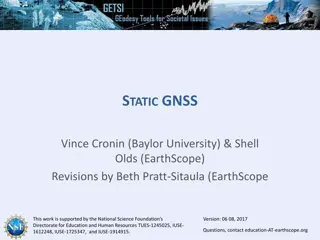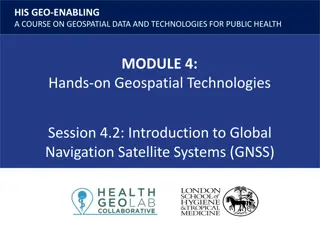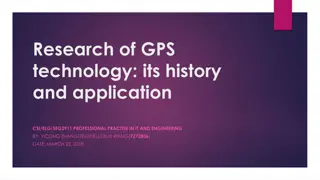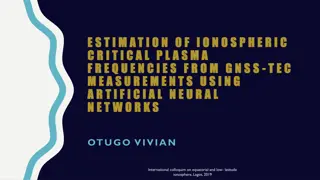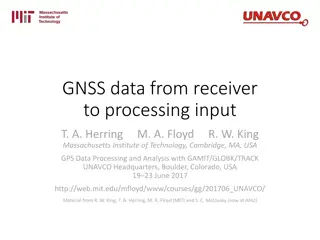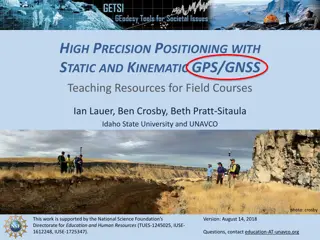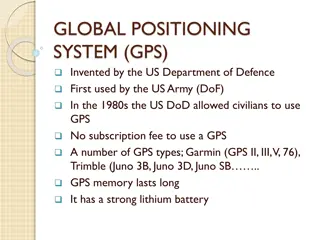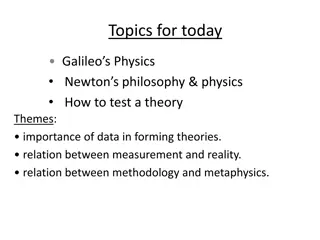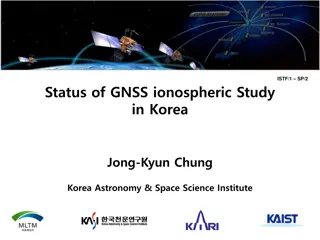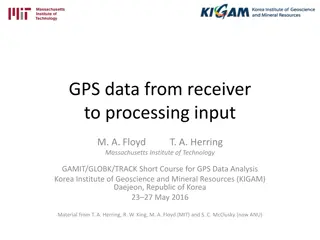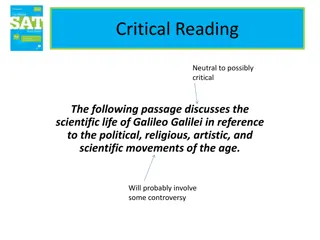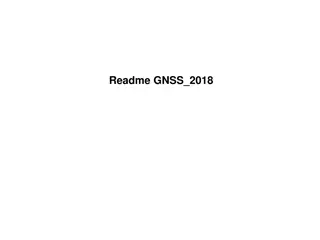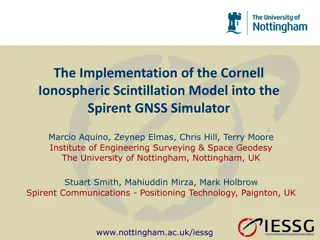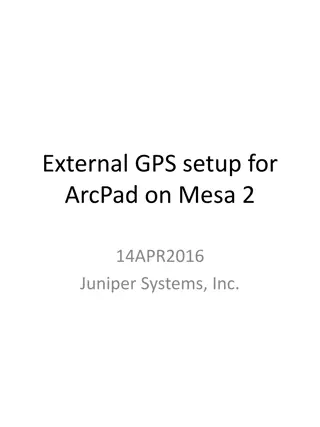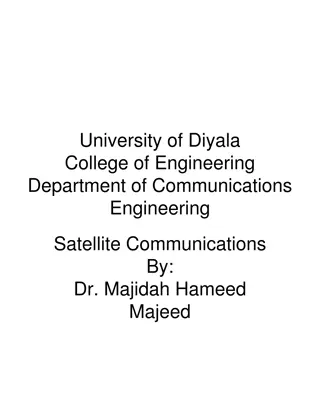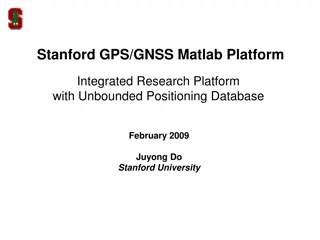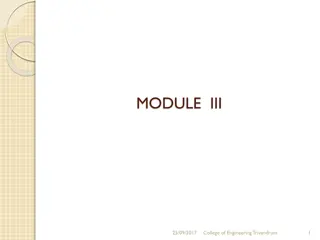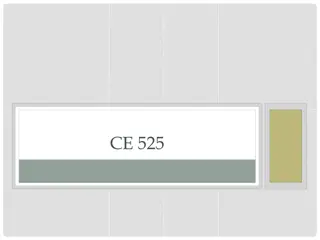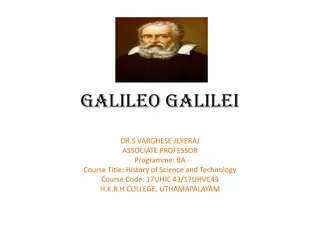Civilian GNSS Signals Overview: GPS, GLONASS, Galileo
An insightful lecture on civilian GNSS signals by Dr. Ali Albu-Rghaif covers GPS, GLONASS, and Galileo signals. The content delves into GPS signal modulation, generation, receiving, and demodulation processes, highlighting the carrier wave, navigation data, and spreading sequences. It also discusses GLONASS and Galileo signals, emphasizing modernized versions and their frequencies, ideal for understanding software-defined GPS and Galileo receivers.
Download Presentation

Please find below an Image/Link to download the presentation.
The content on the website is provided AS IS for your information and personal use only. It may not be sold, licensed, or shared on other websites without obtaining consent from the author.If you encounter any issues during the download, it is possible that the publisher has removed the file from their server.
You are allowed to download the files provided on this website for personal or commercial use, subject to the condition that they are used lawfully. All files are the property of their respective owners.
The content on the website is provided AS IS for your information and personal use only. It may not be sold, licensed, or shared on other websites without obtaining consent from the author.
E N D
Presentation Transcript
GNSS Application 2nd Lecture Civilian GNSS signals By: Dr. Ali Albu-Rghaif Department of Computer Engineering College of Engineering University of Diyala
Outline Civilian GNSS Signals GPS Signals GLONASS Signals Galileo Signals GPS Signal Modulation GPS Signal Generation GPS Signal Scheme GPS Signal Receiving & De-Modulation Acquiring Tracking De-Modulation 2 of 20
GNSS Civilian Signals GPS Signal L1-C/A Signal (BPSK - CDMA) Spreading sequences Modernized L1C Signal Modulation Modernized L2C Signal Modernized L5 Signal A Software-Defined GPS and Galileo Receiver A Single-Frequency Approach 3 of 20
GNSS Civilian Signals GLONASS Signal L1 Signal (BPSK - FDMA) Modernized L1 Signal (CDMA) Modernized L3 Signal (CDMA) centered at 1202.025 MHz Modernized L5 Signal A Software-Defined GPS and Galileo Receiver A Single-Frequency Approach 4 of 20
GNSS Civilian Signals Galileo Signal L1-OS Signal (BOC - CDMA) E5-SOL Signal centered at 1207.14 MHz A Software-Defined GPS and Galileo Receiver A Single-Frequency Approach 5 of 20
GNSS Frequencies A Software-Defined GPS and Galileo Receiver A Single-Frequency Approach 6 of 20
GPS Signal Modulation Signals and Data The GPS signals are transmitted on two radio frequencies in the UHF band. The UHF band covers the frequency band from 500MHz to 3GHz. These frequencies are referred to as L1 and L2 and are derived from a common frequency, ?? = 10.23MHz: ??? = 154 ?? = 1575.42 MHz ??? = 120 ?? = 1227.60 MHz The signals are composed of the following three parts: Carrier Navigation data Spreading sequence A Software-Defined GPS and Galileo Receiver A Single-Frequency Approach 7 of 20
GPS Signal Modulation Carrier: The carrier wave with frequency ??? or ??? Navigation data The navigation data contain information regarding satellite orbits. This information is uploaded to all satellites from the ground stations in the GPS Control Segment. The navigation data have a bit rate of 50bps the time of 1bit is 20ms Spreading sequence Each satellite has two unique spreading sequences or codes. The first one is the coarse acquisition code (C/A), and the other one is the encrypted precision code (P(Y)). The C/A code is a sequence of 1023 chips and repeated each ms chipping rate of the C/A is 1.023 MHz. A Software-Defined GPS and Galileo Receiver A Single-Frequency Approach 8 of 20
GPS Signal Modulation A Software-Defined GPS and Galileo Receiver A Single-Frequency Approach 9 of 20
GPS Signal Modulation BPSK Modulation A Software-Defined GPS and Galileo Receiver A Single-Frequency Approach 10 of 20
GPS Signal Receiving & De-Modulation Receiver Channels The figure below illustrate one receiver channel. The acquisition gives rough estimates of signal parameters. These parameters are refined by the two tracking blocks. After tracking, the navigation data can be extracted and pseudoranges can be computed. A Software-Defined GPS and Galileo Receiver A Single-Frequency Approach 11 of 20
GPS Signal Receiving & De-Modulation Acquisition The purpose of acquisition is to identify all satellites visible to the user. If a satellite is visible, the acquisition must determine the following two properties of the signal: Frequency: The signals are affected by the relative motion of the satellite, causing a Doppler effect. The Doppler frequency shift can in the case of maximum velocity approach values 10 kHz. For a stationary receiver on Earth will never exceed 5 kHz. Code Phase: The code phase denotes the point in the current data block where the C/A code begins. If a data block of 1 ms is examined, the data include an entire C/A code and thus one beginning of a C/A code. A Software-Defined GPS and Galileo Receiver A Single-Frequency Approach 12 of 20
GPS Signal Receiving & De-Modulation Parallel Code Phase Search Acquisition A Software-Defined GPS and Galileo Receiver A Single-Frequency Approach 13 of 20
GPS Signal Receiving & De-Modulation Parallel Code Phase Search Acquisition A Software-Defined GPS and Galileo Receiver A Single-Frequency Approach 14 of 20
GPS Signal Receiving & De-Modulation Tracking The acquisition provides only rough estimates of the frequency and code phase parameters. The main purpose of tracking is to refine these values, keep track, and demodulate the navigation data from the specific satellite (and provide an estimate of the pseudorange) A Software-Defined GPS and Galileo Receiver A Single-Frequency Approach 15 of 20
GPS Signal Receiving & De-Modulation Carrier Tracking A Software-Defined GPS and Galileo Receiver A Single-Frequency Approach 16 of 20
GPS Signal Receiving & De-Modulation Code Tracking A Software-Defined GPS and Galileo Receiver A Single-Frequency Approach 17 of 20
GPS Signal Receiving & De-Modulation Navigation Data Decoding The output from the tracking loop is the value of the in-phase arm of the tracking block truncated to the values 1 and 1. Theoretically we could obtain a bit value every ms. A Software-Defined GPS and Galileo Receiver A Single-Frequency Approach 18 of 20
Summary You be able to distinguish between different types of Civilian GNSS signals The modulation of the GPS signal is illustrated and you know that the L1C/A code signal is based BPSK modulation We have explained the demodulation process such as Receiving, Acquiring, Tracking and Decoding 19 of 20
Reference A Software-Defined GPS and Galileo Receiver A Single- Frequency Approach Birkhauser Boston Basel Berlin 2007 20 of 20
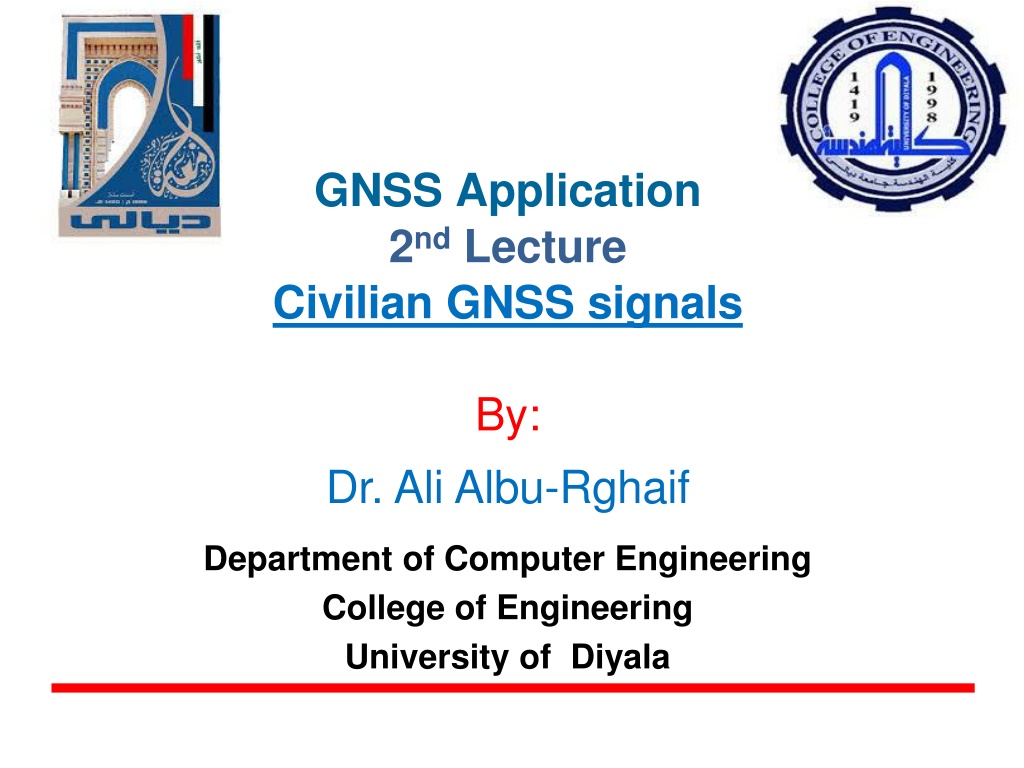









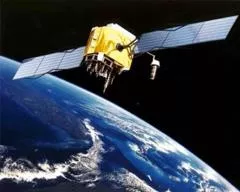


![Read⚡ebook✔[PDF] Io After Galileo: A New View of Jupiter's Volcanic Moon (Sprin](/thumb/21612/read-ebook-pdf-io-after-galileo-a-new-view-of-jupiter-s-volcanic-moon-sprin.jpg)
